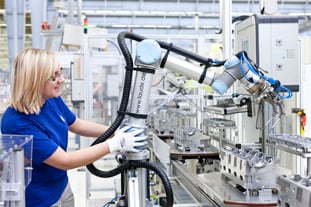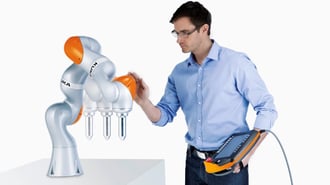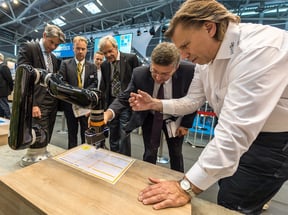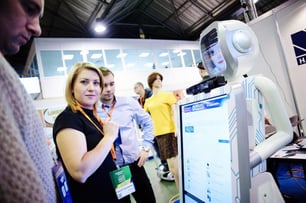Key Leaders for Rapid Deployment of Collaborative Robots in a Global Company

Posted on Jun 04, 2015 10:47 AM. 6 min read time
Collaborative robots are meant to be easy to use and integrate. They are designed to be similar to a worker’s tool and require little knowledge of robotics to use them. This is great for Small or Medium Enterprises (SME). This can also be a great advantage for bigger companies looking for a more agile approach to automation. In global companies spanning across different plants and geographic areas, you need a concerted effort to deploy collaborative robots successfully. Here is the profile of 4 key players to consider when looking at deploying collaborative robots within your global company.
As we have observed, there are four key leaders that need to be involved for a successful large scale deployment of collaborative robots.
1. Innovative Plant Leader
 Role: Ice Breaker
Role: Ice Breaker
-
Install the first robot in one of the plants, start a pilot project. The main goal is to build an internal knowledge base and create a precedent, a first case people can relate to internally.
-
Take the first visible step on the global effort. Keep in mind that a global company can use the same device for different applications.
-
- Profile: The plant leader has to be convinced by the potential of collaborative robots for the enterprise. His biggest resource is to have strong leadership and believe in the advantages of technology.
-
S/he can be a plant manager or manufacturing engineer with great leadership.
-
Hands free to try new things.
-
Great leader able to manage change and get workers onboard, communicate, explain to other plants.
-
Innovative, looking for opportunities to grow professionally and increase the comfort zone of his company.
-
2. Corporate Tech Center Engineer
 Role: Technology Expert
Role: Technology Expert
-
Study the collaborative robot current and future landscape. Benchmark technologies. Understand safety standards and how to apply them in the company's context. Document for internal sharing.
- Support the first integration by the innovative plant leader.
- Once the first project is done in a plant, organize a workshop event to explain to higher management and other plant managers.
-
- Profile: Knowledgeable in robotics, the ''tech guy'' will get through the learning curve for the collaborative robot and its integration.
-
Highly skilled engineers with good communication skills, able to popularize technological concepts.
-
Connected to plant operation reality and corporation financial and strategic reality. Must be seen by the plant managers and higher management as someone with credibility, not someone who only "likes to play with cool technology". The doors of the factories and higher level offices must be open for him to get in at any time.
-
3. Visionary High Level Manager
 Role: The Godfather
Role: The Godfather
-
Create a ‘passing pocket’ for the plant leader deploying the first application. Allow time for the workers to work with the technology and adopt it. Remember, the first application is mostly to build the internal know how, a first example for something much bigger to come.
-
Make sure budgets are approved. Knowing that budgets can be a very limiting aspect to introducing a robot into a plant, make sure to reflect the potential of the technology.
-
Communicate with other managers. Managers from the same level and from higher levels would also like to know what’s cooking with this robot. Let them know what is going on using a ''management'' oriented vocabulary rather than a technical one.
-
- Profile: Be connected with worker reality and their issues.
-
Open minded, innovative, leadership.
-
4. Global Purchaser
 Role: The Streamliner
Role: The Streamliner
-
Collaborative robots are easy to deploy, easy to use. They should be as easy to buy for the plant manager wanting to generate ROI on his floor. The global purchaser will put agreements in place with suppliers to streamline ordering. Purchasing is part of the deployment process, should be as simple and easy as the rest to get the full benefits of agility.
-
- Profile: Have an idea of the global issues and what goes on in the other plants nationally or worldwide.
-
Result oriented. Once again keeping a global approach will simplify the global integration of the technology.
-
Bonus expert to get onboard
The Communications Wizard
- Role: Ghost writer
 Work with the Visionary High Level Manager to develop communications for the top management in the company. Design communication tools to show what are the actual issues, benefits and costs of the project, as well as setting expectations at the right level. Make sure that the message stays at a management vocabulary level.
Work with the Visionary High Level Manager to develop communications for the top management in the company. Design communication tools to show what are the actual issues, benefits and costs of the project, as well as setting expectations at the right level. Make sure that the message stays at a management vocabulary level.- Work with Innovative Plant Leader to communicate the integration of the new robotic cell for the floorshop. This process must be done long before the robot installation itself. The Plant Leader and the Communication Wizard have to orient their communications around the issues and benefits than the employees get by integrating the new technology. Communication tools must be developed to highlight the ergonomic, redundant and boring task issues including the problems that can develop from them, as well as showing what the day-to-day job of an employee will look like once the technology is integrated. The idea is to show that the robot is just another new tool in their tool box and once integrated the employee will continue to work at their station but on tasks that will add more value to the product. In brief, it is crucial to make the employee(s) comfortable with the situation before putting a robot on the shopfloor.
- Work with Corporate Tech Center Engineers to communicate the first integration to other plants. Make sure that other plant managers understand the technology and its benefits, but also all the processes on both a technical and communications level to make sure that the integration is a success.
- Profile: Understand quickly what the concerns of different targeted audiences are. Team player that can work with technical people, high management and people from production. Accepts his/her role to be a ghost writer, not a spokesperson.
- Open-minded and quickly capable of having an overview of issues and challenges. Must be able to foresee what will be the show stoppers in people’s minds.
- Must be able to work with people from different backgrounds, mindsets and attitudes to their day-to-day work.
- Open-minded and quickly capable of having an overview of issues and challenges. Must be able to foresee what will be the show stoppers in people’s minds.
From the experience that we've seen, having these 4 leaders working together really increases the likelihood of rapid adoption of collaborative robots in global companies. Typically, we see the leadership coming from the Tech Center. This is great, you need expertise at that level. But to really speed things up, you need the rest of the team. The real catalyst is usually the innovative plant leader. Once you have a first practical example, the internal buzz starts building both at a management and plant level. Adding collaborative robots can improve productivity, ergonomics and the bottom line. If you're serious about it, you must have the right people to make it happen!
Related Articles:
Why collaborative robots are even more interesting for global companies?

 Role:
Role: Role: The Godfather
Role: The Godfather
 Role: The Streamliner
Role: The Streamliner
 Work with the Visionary High Level Manager to develop communications for the top management in the company. Design communication tools to show what are the actual issues, benefits and costs of the project, as well as setting expectations at the right level. Make sure that the message stays at a management vocabulary level.
Work with the Visionary High Level Manager to develop communications for the top management in the company. Design communication tools to show what are the actual issues, benefits and costs of the project, as well as setting expectations at the right level. Make sure that the message stays at a management vocabulary level.






Leave a comment